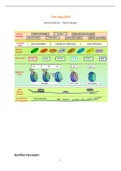Samenvatting
Samenvatting keuzevak Genregulatie - BMW UvA ()
- Instelling
- Universiteit Van Amsterdam (UvA)
Uitgebreide samenvatting (99 blz.) van tentamenstof voor het tentamen van het keuzevak Genregulatie. Begrippen en concepten van de hoorcolleges zijn uitgebreid toegelicht en uitleg van bijbehorende figuren uit de colleges is hierbij ook verwerkt. De samenvatting is voornamelijk in het Engels geschr...
[Meer zien]




